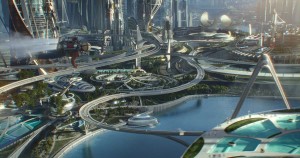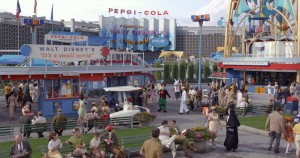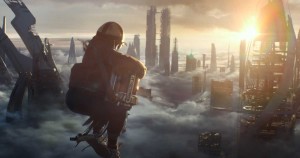
Company 3 recently relied on Blackmagic Design‘s DaVinci Resolve to grade Tomorrowland. As the movie is the first title to be released in Dolby Vision, Company 3 also used DaVinci Resolve to create a pass for the new projection system.
Directed by two-time Oscar winner Brad Bird (Ratatouille, The Incredibles) and shot by Oscar-winning DP Claudio Miranda (Life of Pi), Tomorrowland follows Frank Walker (George Clooney), a former boy genius inventor, and Casey Newton (Britt Robertson), a bright teen bursting with scientific curiosity, as they embark on a danger-filled mission to unearth the secrets of an enigmatic place somewhere in time and space that exists in their collective memory as Tomorrowland.
 “Tomorrowland is somewhat brighter and more saturated than real life, but it’s not an extreme look, as there are no crushed blacks or clipped highlights,” said Stephen Nakamura, color grader at Company 3. “I built a lot of Power Windows in Resolve to very subtly help smooth out the effects. The movie is full of wild, elaborate visual effects, and there are always some enhancements that we can do in the grade when we see everything projected and in context with the other shots.”
“Tomorrowland is somewhat brighter and more saturated than real life, but it’s not an extreme look, as there are no crushed blacks or clipped highlights,” said Stephen Nakamura, color grader at Company 3. “I built a lot of Power Windows in Resolve to very subtly help smooth out the effects. The movie is full of wild, elaborate visual effects, and there are always some enhancements that we can do in the grade when we see everything projected and in context with the other shots.”
According to Nakamura, there is an amazing VFX sequence when one of the characters first enters the world of Tomorrowland. He explained: “It’s a roughly two-minute-long moving shot with an enormous number of elements that Industrial Light & Magic created. I was color grading at ILM while they were building the effects, and I used Resolve’s soft clip and highlight tools within Color Match, along with some chroma keys, to increase and decrease saturation from particular portions of the frame.”
 Nakamura also used DaVinci Resolve’s soft clip and highlight features during the Dolby Vision pass.
Nakamura also used DaVinci Resolve’s soft clip and highlight features during the Dolby Vision pass.
“When converting the files from the traditional d-cinema P3 format into the PQ format, you can make the brightest part of the frame more than twice as bright, and you can get really deep blacks. Brad and Claudio were interested in taking advantage of this high dynamic range, just in a subtle way,” said Nakamura. “A lot of the Dolby Vision grade was really about re-interpreting the material so it has a wider dynamic range without overpowering anything. For example, a bright part of the frame, like a lamp, wouldn’t completely overpower the actors’ faces as it potentially could.”
“Even though the Dolby Vision pass gave me the potential to let highlights go brighter than anything you’d ever see in traditional d-cinema,” he concluded, “I used DaVinci Resolve’s soft clip and highlights features a lot to help retain the original feel of the standard 14 foot-lambert version in the Dolby Vision 31.5 foot-lambert version.”





